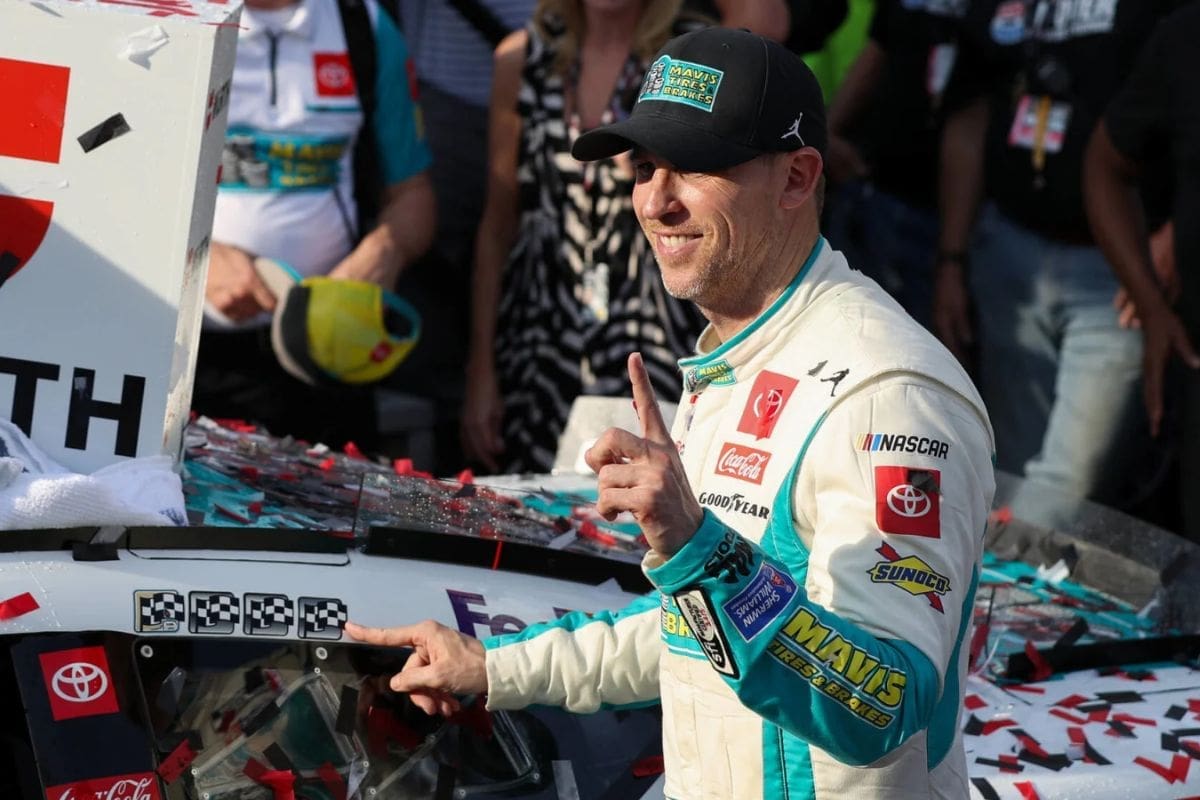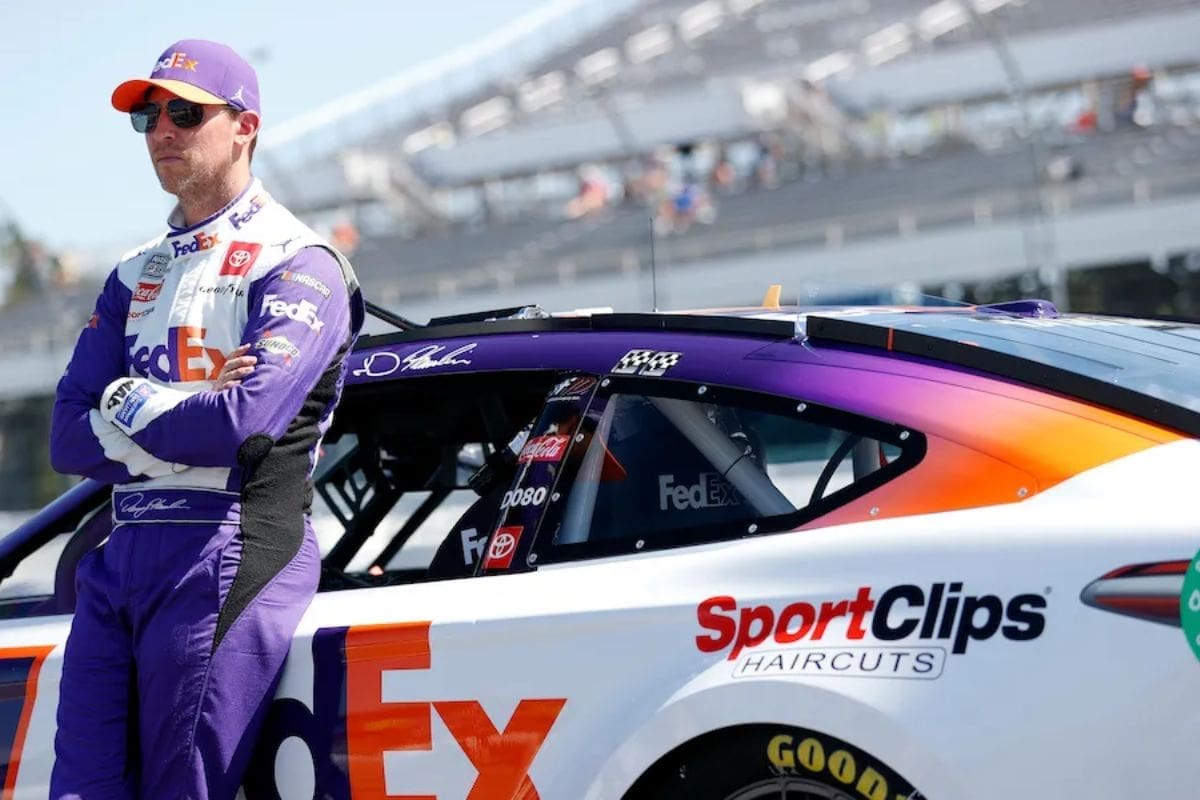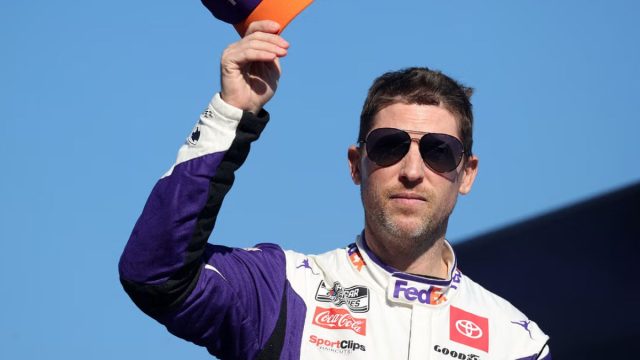Denny Hamlin’s Bold 10M Dollar Demand: Denny Hamlin‘s audacious proposal to institute a $10 million reward for a perfect NASCAR bracket entry has set the stage for a potential paradigm shift in fan engagement within the sport. Following the complete wipeout of all 31,000 entries in the recent Bracket Challenge, Hamlin’s initiative highlights the inherent unpredictability of NASCAR racing. By drawing inspiration from the NCAA’s bracket system, Hamlin aims to infuse a new level of excitement and involvement among fans. Yet, the implications of this high-stakes incentive raise several intriguing questions about its feasibility and impact on the sport’s dynamics.
Key Highlights
- Denny Hamlin proposed a $10 million incentive for anyone creating a perfect NASCAR Bracket Challenge.
- Hamlin highlighted the unpredictability and complexity of predicting NASCAR race outcomes.
- The Bracket Challenge saw all 31,000 entries fail to remain unscathed due to race volatility.
- Hamlin compared the challenge’s difficulty to achieving a perfect NCAA tournament bracket.
- His proposal aims to boost fan engagement and excitement in NASCAR.
Key Events in the Race
What significant moments unfolded during NASCAR’s Cup race in Illinois that set the stage for Denny Hamlin’s bold $10M demand?
The race was filled with drama and unforeseen mechanical failures that reshaped the trajectory of the competition. Christopher Bell, a prominent frontrunner from Joe Gibbs Racing, dominated much of the race by leading 80 laps. Bell’s performance was a confirmation of his skill and strategy, marking him as a formidable contender for his third win of the season.
However, the unpredictability of motorsport reared its head with just 19 laps remaining. Bell’s engine failure was a critical incident that altered the dynamics of the race. The sudden mechanical issue not only dashed Bell’s victory hopes but also sent shockwaves through the field, opening opportunities for other drivers to capitalize on his misfortune. The engine failure was unforeseen, contributing to the intense atmosphere and highlighting the inherent uncertainties of racing.
Meanwhile, this incident was just one of the events that set the stage for Denny Hamlin’s subsequent bold demand for a $10 million payout. As the race progressed, other competitors faced their own challenges, each event contributing to a complex and competitive environment. Hamlin, known for his strategic expertise, was closely observing these developments, likely calculating his next move.

Introduction of the Bracket Challenge
In a creative twist to traditional NASCAR events, Denny Hamlin introduced the Bracket Challenge at the World Wide Technology Raceway, aiming to engage fans through a competitive and interactive betting system. This inventive concept was designed to add excitement to the race weekend, as fans were invited to participate in head-to-head matchups by voting for their favorite drivers. The structure of the challenge mimicked the popular bracket format seen in other sports, bringing a fresh, engaging element to the racing world.
Hamlin’s vision for the Bracket Challenge was not merely an afterthought but a carefully planned endeavor to enhance fan engagement and interaction. By incorporating a competitive edge into the fandom experience, Hamlin hoped to draw in a more diverse audience, including those who might not typically follow NASCAR. Fans were able to cast their votes in the initial round at the Enjoy Illinois 300, where picking the correct matchup awarded them 10 points. This scoring system was intended to heighten the anticipation and make every vote count.
However, the unpredictability of the races added a layer of complexity that took even seasoned fans by surprise. Despite the challenge’s clear structure and the enticing prospect of points and potential prizes, no one managed to accurately forecast the outcomes. This unpredictability highlighted the inherent excitement of NASCAR, yet also emphasized the difficulty in making precise predictions in a sport where variables can change rapidly.
Denny Hamlin Bracket Challenge upsets today:
31 Dillon over 2 Truex
25 Nemechek over 8 Bowman
21 Gragson over 12 Blaney
20 Cindric over 13 Wallace
17 Logano over 16 Briscoe— Jeff Gluck (@jeff_gluck) June 2, 2024
The Underdogs and Race Results
The race at the World Wide Technology Raceway saw an unexpected twist as underdog Austin Cindric seized victory, shaking up the brackets and leaving no flawless entries after the initial round. In a dramatic turn of events, Cindric capitalized on the misfortunes of front-runners Christopher Bell and Ryan Blaney. Bell faltered, and Blaney ran out of fuel in the pivotal final laps, paving the way for Cindric’s remarkable win.
The consequences of this outcome were felt immediately in the Bracket Challenge, where 31,000 entries were submitted but none emerged unscathed after the opening round. According to ‘Actions Detrimental’ co-host Jared Allen, ‘Austin Cindric plays a role in busting a lot of brackets, actually busted all the brackets…submitted all 30. He eliminated Bubba…’. This highlights the unpredictable nature of motorsport, where even carefully crafted predictions can be upended by unforeseen variables.
“We had 31,000 brackets submitted, there’s no longer a perfect bracket after round 1.” – (Jared Allen)
Cindric’s victory highlights the dynamic potential of underdog drivers in the racing world. His success is a confirmation of strategic insight and resilience, qualities that often go unnoticed until they manifest in such spectacular fashion. Not only did he defy expectations, but he also demonstrated the volatility and excitement inherent in the sport.

Hamlin’s Commentary on the Bracket Challenge
Denny Hamlin’s recent remarks on the Bracket Challenge highlight the inherent unpredictability of motorsport, proposing a $10 million incentive for a perfect bracket to demonstrate its complexity. Hamlin’s assertion emphasizes the sheer volatility that defines NASCAR, drawing a parallel to the NCAA basketball tournament to highlight the difficulty in predicting race outcomes. His comments suggest that while both sports are unpredictable, NASCAR’s element of attrition and the interplay of numerous variables raise the challenge to an extraordinary level.
Hamlin stated, “NASCAR needs to offer $10 Million to a perfect bracket because it’s not gonna happen first…It is more difficult than the NCAA bracket, and NCAA has more teams…because of the unpredictability.” This comparison effectively highlights the intricacies that make motorsport bracket predictions particularly challenging. Hamlin elaborated that factors such as speed consistency and unexpected eliminations significantly influence race results, making accurate predictions nearly impossible.
“It’s attrition, and if this goes off of flat out speed in every track, it’s easy to handicap but it doesn’t go that way. I just said, 30% of your competition will eliminate itself.” – (hamlin)
“There’s no way any bracket predictor can predict Austin Dillon over Truex. It’s just impossible. I mean, for God’s sake, thank god we finished second ’cause Justin Haley was seven spots away from eliminating me!” – (hamlin)
- Attrition Rate: Hamlin noted that approximately 30% of competitors might eliminate themselves, making it demanding to forecast.
- Underdog Victories: Unexpected outcomes, such as Austin Dillon outperforming Truex, exemplify the challenge.
- Dynamic Variables: Race outcomes depend on many factors beyond mere speed, including weather, mechanical failures, and strategic decisions.
- Comparative Difficulty: By comparing it to the NCAA bracket, Hamlin highlights the heightened complexity due to fewer predictability metrics in NASCAR.
Impact of the Next-Gen Car
Revolutionizing the landscape of NASCAR, the introduction of the Next-Gen car in 2022 has greatly heightened the sport’s unpredictability and leveled the playing field. This groundbreaking innovation, characterized by parts from single-source suppliers, has dismantled the era where drivers carefully fine-tuned their vehicles for maximum performance. The result is a more balanced competition, evidenced by the unexpected names that surfaced in the top-ten, such as Austin Cindric, Austin Dillon, and Justin Haley. Race betters have found themselves bewildered, grappling with the new dynamics that the Next-Gen car has introduced.
In 2022, the Next-Gen car’s debut season, the NASCAR landscape was remarkably transformed. A staggering 19 different winners emerged over 36 races, including five inaugural victors and two drivers who secured their opening shots at a championship. NASCAR President Steve Phelps highlighted this shift, contrasting it with the pre-Next Gen era where alliances with a handful of elite race teams were crucial for success.
“Before this year (and) the Next Gen car, you had to have a relationship with one of five race teams if you wanted to come into this sport. This car changed that.” Phelps remarked, emphasizing the democratizing effect of the new vehicle.
However, this extreme parity has not been without its drawbacks. While leveling the playing field fosters inclusivity, it also risks diluting the racing product and diminishing fan entertainment value. Denny Hamlin’s assertive $10 million demand may serve as a catalyst, motivating drivers to aim for dominance even within this newly balanced framework. The Next-Gen car has indeed reshaped NASCAR, but its long-term impact on the sport’s competitive essence and spectator appeal remains a topic of intense scrutiny.

News in Brief: Denny Hamlin’s Bold 10M Dollar Demand
Hamlin’s proposal of a $10 million incentive highlights the inherent unpredictability and strategic complexity of NASCAR racing. By integrating a high-stakes bracket challenge, the initiative aims to enhance fan engagement and excitement, mirroring the enthusiasm seen in NCAA brackets.
This move, coupled with the introduction of the Next-Gen car, signifies a pivotal period in NASCAR, enriching the sport’s appeal and emphasizing its dynamic, competitive nature.
Also Read: Denny Hamlin Reveals NASCAR’s Crafty Stance on Charter Deals
